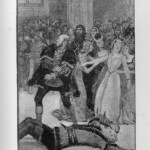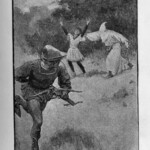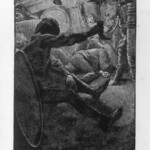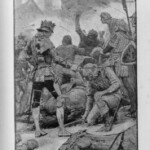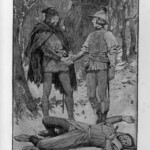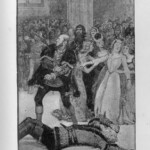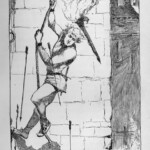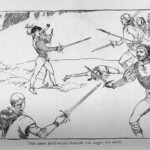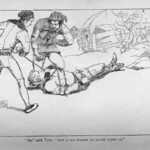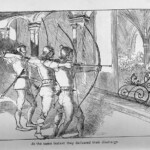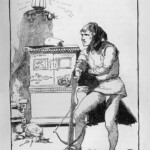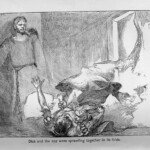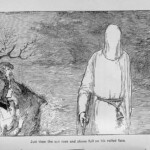The Black Arrow has an interesting publishing history, and holds an unusual place in Stevenson’s catalogue. It first appeared as the follow-up syndicated story to Treasure Island in Young Folks in seventeen weekly instalments between 30 June and 20 October 1883.[i] This story, unlike Treasure Island, was heavily illustrated, perhaps a sign of Stevenson’s rising star as a popular author, although ironically it was this story that helped launch him to fame rather than its predecessor. James Henderson, editor of Young Folks, had requested another story to follow Treasure Island, and Stevenson began writing in May 1883. From the outset, he was not happy with his work, which he wrote through the fog of yet another illness. However, he did gradually come to see strengths in the work. He wrote to Sidney Colvin in November 1883, after the end of publication, expressing his pride at his rendering of “Crookback”, and finishes his comments by remarking “It’s great sport to write tushery”. [ii] This last comment has been interpreted as outright criticism of his story, but as is often the case with Stevenson’s self-criticism, it must be taken as ambiguous: critical, certainly, but also self-deprecating about a work he came to appreciate.
In terms of its elevation to book form, nothing would happen with The Black Arrow for the next few years. For the purposes of this study of book illustration, it is interesting to note that it was in America, rather than Britain, that the novel was not only first published but illustrated. Communicating with Samuel McClure from Saranac Lake, on his way eventually to the Pacific, Stevenson arranged an American edition of The Black Arrow both as a syndicated serialisation in The Philadelphia Press, and subsequently as an illustrated book through Charles Scribner’s Sons in 1888. This is poignant, given that the same was true for the illustrated book version of Treasure Island; it was in America, with the Roberts Brothers 1884 edition that Treasure Island was first illustrated in book form with four images by F. T. Merill. A British version appeared the following year from Cassell and Company, but the illustrations were completed by a French artist, Georges Roux. This may point to the fact that it was American publishers and readerships that were pushing, even innovating, in the illustrated novel at the end of the nineteenth century; British publishers, by contrast, seemed initially to resist the illustrated book form of Stevenson’s stories. Cassell and Company published a book version of The Black Arrow in 1888, shortly after the appearance of Scribner’s Sons’ version, but it was not illustrated. They produced an illustrated version finally in 1891, with illustrations by H. M. Paget, reproduced here.
Stevenson’s reaction to Merill’s illustrations to Treasure Island had been less than complimentary. Writing to Charles Scribner from Saranac Lake in October 1887 about a new edition of Treasure Island, he advises, “Should you get Treasure Island, remember to sack the disgusting American illustrations; and get from Hetzel, Roux’s very spirited pictures…”.[iii] This comment may appear on the surface to be somewhat anti-American; however, as Stevenson moved ever further west and south in his travels, he still pushed for the illustration of his work, and Scribners was more than happy to oblige. In the same letter quoted above, Stevenson mentions an American artist he much admired, writing that “Roux is really very spirited, though I wish I had known of [Howard] Pyle, for the French faces jar”. Pyle was an illustrator for Scribners, who wrote and illustrated his own children’s books, a feat Stevenson aspired towards (although acknowledging his own limitations as an artist). Another American artist he admired was his good friend William H. Low. Having failed to convince the company to hire Pyle to illustrate both the book form and serialisation of The Black Arrow, McClure offered to serialise The Black Arrow under the title of “Outlaws of Tunstall Forest” in The Philadelphia Press from 25 March 1888, and had Low illustrate the story. One of these illustrations appears as the frontispiece to the American edition (fig. BA-US-1); Stevenson appears to have held admiration for Low’s pictures. Responding to praise for the serialised Black Arrow from the American journalist Talcott Williams, he writes, “I liked your kind praise; and the whole business—récalme, pictures and cut down story—is entertaining and novel”.[iv]
The remainder of the book illustrations are done by Alfred Brennan, another syndicated illustrator for Scribners who would incur Stevenson’s displeasure with illustrations to his final completed story The Ebb-Tide, for Jerome K. Jerome’s To-day periodical in 1894. In the light of this criticism, it is therefore worth noting Stevenson’s uncharacteristic silence in his correspondence regarding Brennan’s illustrations for The Black Arrow. This may be a coincidence of his travelling and various other distractions, but his silence may also be conceived as damning. He is similarly silent on H. M. Paget’s pictures for the British edition. Whatever his feelings on these images, he was bound through distance and nineteenth-century modes of communication to rely on artists and publishers miles away. Stevenson was limited in his influence over the choice of illustrations and illustrators, given his geographic distance from his publishing centres. This is a problem that would come back to haunt him with later publications; in the main, he had to trust to the tastes of his publishers, and the availability of certain illustrators, although he did make recommendations when he could.
The Black Arrow therefore received four illustrative treatments during his lifetime, two in Britain and two in America: in Young Folks, The Philadelphia Press, and in Charles Scribner’s Sons’ and Cassell and Company’s book editions. The illustrations reproduced here are the book illustrations from the latter two versions. It is interesting to note the contrast in styles of illustration, as Brennan’s illustrations bear close stylistic resemblance to his American predecessor Merill’s for Treasure Island; Paget’s, by contrast, seem more akin to Roux’s pictures in their more naturalistic use of light and shade. The American illustrations favour woodcut designs, where the British illustrations are photographic reproductions of paintings by the illustrators. Stevenson seems to have been uncomfortable with the former design, which emphasises the drama through a stark linear style. Illustrations for future American publications, of which Stevenson generally approved, reverted to Paget’s more painterly style, particularly those by William Hole for The Master of Ballantrae, and Gordon Browne for “The Beach of Falesa”. The illustrations for all four versions of The Black Arrow cover all the various styles of illustration that Stevenson’s works were subsequently subject to, and demonstrate among other things the variety of pictorial possibilities that his prose opened up for potential illustrators.
[i] Roger Swearingen, Prose Writings of Robert Louis Stevenson: A Guide (Connecticut: Archon Books, 1980), p. 83.
[ii] Robert Louis Stevenson, The Letters of Robert Louis Stevenson, ed. Bradford A. Booth and Ernest Mehew (New Haven and London: Yale University Press, 1994), 8 vols. 4:199.
[iii] Letters, 6:40.
[iv] Letters, 6: 143. The reference here to the “cut down” story refers to the cutting of five chapters from the beginning of the Young Folks versions on McClure’s insistence.
Black Arrow (UK)
Illustrations by H. M. Paget
All images Courtesy of the The Writers Museum
Black Arrow (US)
Illustrations by Howard Pyle and Alfred Brennan
All images Courtesy of the The Writers Museum

